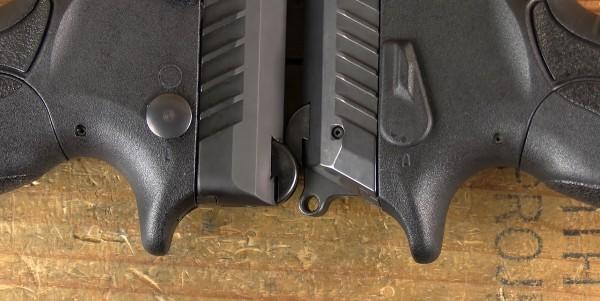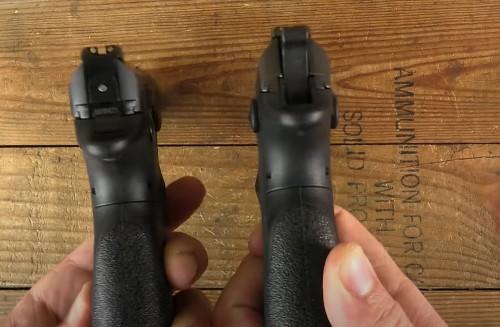The majority of new shooters have not known well about Striker Fired vs. Hammer Fired Guns. Some argue that the two guns are nearly the same, so owning one of them can meet all of your needs.
That is just not the case, especially when it comes to concealed carry and your degree of shooting skill. The decision between a hammer and a striker-fired handgun is based on the intended use, personal choice, and optimal feel.
This post will give you some basic differences between the two types; let’s kick it in.

Contents
Striker Fired vs. Hammer Fired Guns – Learning The Difference
We will compare the two types of guns based on four main features: action, design, readiness, and efficiency.
Action
About Striker-Fired Guns
The firing pin is located at the end of the striker on most striker-fired handguns, like Smith & Wesson M&P. Initially, these striker-fired guns were controlled by the slide action, and the trigger activated the sear to fire the shots.
This isn’t the safest setup, especially with low-cost pistols. With GLOCK-like actions, there is actually a two-stage procedure. The trigger is partially prepared against the striker springs when the slide is racked. That’s the position when you’re ready to go.
A firing pin block helps stop the striker from moving forward, and the strikers, if discharged from half-cock, will most likely be unable to fire the primer.
When you press down on the trigger with your finger, it presses on an action bar, which then presses on the stricker. The striker goes to the back, the firing pin block slides away, and the striker travels forward against spring pressure.
The handgun goes off. The procedure starts all over again.
About Hammer Fired Guns
The slide of a hammer-fired handgun is racked, and the hammer is cocked as a result of this operation. The hammer is kept entirely in the rear position by locking into the sear and using a mainspring.
Most separate handguns contain a manual safety that permits the pistol hammer to be carried to the rear while the safety is engaged. When done correctly, this is a highly safe setup. To shoot the pistol, you need to first set the safety to the off position.
The hammer is released when the trigger is placed on the sear. The hammer is propelled forward by the mainspring. The hammer’s face smacks the firing pin.
The firing pin is pushed forward until it comes into contact with the cartridge primer. The handgun goes off. The firing pin is dragged to the rear by the firing pin spring after each shooting, the slide recocks the hammer, and the handgun is ready to fire again.
Design

In general, the designs come in a variety of styles. For example, the Arex Rex Delta striker-fired pistol varies from the Glock and may be preferred by some shooters.
The majority of striker-fired pistols have a lever built into the trigger. There are also the DAO hammer-fired weapons, which have spurless flush-fit hammers.
Striker-fired pistols aren’t all created in the same way. The striker spring in Smith and Wesson, Glock, HK, and other kinds is partially cocked or readied by slide motion.
Like the Arex Rex Delta, several striker-fired designs include a two-stage trigger that can provide great accuracy.
Readiness
Regarding readiness, with the striker-fired handgun, the only way to keep the spring relaxed for long storage is to leave the weapon emptied. The hammer may be readily lowered with a single motion. Neither situation is desirable.
The hammer impacts the primer harder than the striker, but ignition reliability isn’t an issue with the Glock and Arex handguns.
The striker spring is powerful, and the striker is lighter. The latest designs, such as the Colt Series 80 and the Glock, are the perfect choice in two types in terms of trigger and safety action.
Efficiency
Striker fired guns come with a sleek, snag-free slide, creating a great concealed carry. The DAO striker-fired pistol’s manual of arms is straightforward: load, rack the slide, holster, draw, and fire.
A single-action hammer-fired pistol works following this process: load, rack the slide, set the safety, draw, disengage the safety, and fire.
The manuals of arms first-shot handgun in the double-action types are: load, rack the slide, decock the hammer, release the safety in some models, and fire.
Striker Fired vs. Hammer Fired Gun – Which One is Better?

Now, we will provide some pros of Striker Fired and Hammer Fired Guns for you to have the best view.
Pros of Hammer-fired Handguns
- Manual operation to decock and cock
- More capacity for a heavier, thicker hammer and a larger, stronger mainspring
- Offering more options for remedial action due to the capability to manually re-cock
- Simply to manipulate and control the slide compared to a striker-fired handgun
- Better trigger than the typical striker-fired handguns
Pros of Striker-fired Handguns
- Fewer pieces, but not all models
- Offer affordable price
- Simple to function, disassemble, and maintain the guns
- More light-weight
- Compact design
- A lower bore axis (the distance between the bore of the gun and the shooter’s hand)
Indeed, striker-fired handguns are simpler, have fewer components, and are thus less expensive. They are frequently chosen by police enforcement.
Conclusion
Through this article, we have shown you a thorough comparison between Striker Fired vs. Hammer Fired Guns – two preferable names in the handgun forums recently.
From our perspective, striker-fired guns perform better in defense scenarios, although hammer-fired weapons can also be effective. Additionally, new shooters can learn more efficiently with hammer-fired guns, while some old-school shooters may prefer them.
Thank Graham Baates for the images!

I am Jerry Gonzalez, and my heart beats for the great outdoors, especially in the breathtaking landscapes of Helena, Montana. Engaging with fellow enthusiasts online and at local hunting clubs has been a rewarding experience, and I find great joy in sharing knowledge and experiences with like-minded individuals. My goal is to empower my fellow hunters with well-informed choices, regardless of their experience level.
